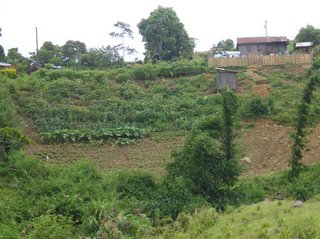So I’m in Malaybalay, the capital city of the province of Bukidnon. I got here on July 24th so obviously I’m ridiculously behind in posting this blog! My only excuse (but oh, it’s a doozy) is that the center set-up here has been “interesting”, to say the least. (In this case, “interesting” means that on the one hand the trainers here are awesome and strong in both computers and teaching and the center manager has great ideas. On the other hand, we’re still working on getting our set-up budget and the venue prepared and before Wednesday every one of the four identified trainers had full-time jobs that didn’t include training the youth once the center launches. Why yes, there are only 2 working days left before I leave, thanks for asking).
But this is an entry about where I am! Malaybalay is a great city – smaller than the other cities I’ve visited. (I mean, there’s no mall! I know the Ben and Cat are going to freak out if they read that but I haven’t been in a Filipino city yet that didn’t have a mall. ‘Malling’ (window shopping and hanging out at the mall) is a pretty popular pastime here). The city is also very green, apparently the result of a government green-city campaign. We’re up in the mountains so it’s cooler than almost anywhere else in the Philippines, and cooler than Toronto by a long shot :p Filipinos call Malaybalay the “mini-Baguio”, Baguio being a place in the mountains in Luzon that’s the coldest place in the Philippines. It’s cool enough here (I haven’t seen a thermometer since I arrived so I can’t say how cool except that I need a sweater sometimes and a blanket at night) that pine trees grow, and it’s a little strange for me to see pine trees growing next to huge stands of bamboo in the forests! There’s also a large Indigenous population in the province – 7 different tribes and languages under the umbrella term ‘Bukidnese.’
This is also a mainly agricultural province – Dole and Del Monte both have huge banana and pineapple plantations here (and not only are their export bananas tasteless compared to the local ones, they’re also covered in plastic bags while growing on the tree to prevent blemishes. Sorry!). A lot of the people here either work on the multinational plantations or are subsistence farmers.
The gap between the two typs of farms is huge, as you can imagine. I went with Jo, a population worker for the government, to her home municipality of Sumilao. It’s about an hour away on the main (only) highway, and then we went another 12 km along a bone-rattling road to the barangay of Lumpiagan. Lumpiagan is one of the poorest barangays in the province. It’s a handful of houses perched on the top of a cliff overlooking a small, deep valley. On the sides of the valley and the cliffs opposite are peoples’ fields. Some of the fields here are on hills so steep I wonder how the farmers keep their footing when they plant or, when they harveset their cabbages how they keep them from rolling down to the bottom of the valley.
Jo was there to give a talk to the barangay youth on how to make banana chips, as part of a livelihood program. I have to wonder though, is knowing how to make banana chips that useful when those youth have to walk 12 kilometers to get to Sumilao to sell them? It’s a hilly road, and Jo says it takes her at least 2 hours to walk if she takes a shortcut over the side of a steep hill. Their remoteness is why most of the youth from the barangay are out of school – the nearest high school is in Sumilao, and if their families can’t afford to board them there high school kids have to spend at least 4 hours a day walking there and back. A lot of them drop out to start farming instead. Jo also told the kids about SCALA and hopefully some of them can take advantage of it. The municipalities have agreed to cover the cost of board and lodging for their SCALA participants in Malaybalay as well as the cost of transport to get them there, which for the kids in Lumpiagan is essential.
After visiting Lumpiagan we continued on to a ranch whose manager Jo is friends with. It’s owned by one of the rich families in the area and the difference between it and the farms in Lumiagan was overwhelming. This place was huge – and was raising Kobe beef to sell in Manila for a thousand pesos per kilo. (To give you an idea of the shock of that, regular beef here costs about 100 pesos per kilo). The ranch manager was really knowledgeable about farming in the region and the chance to get on a horse for the first time in a long while was great, but it was an unreal afternoon. Two very different sides of life around Malaybalay, that’s for sure
Lumpiagan

Steep fields.



1 comment:
Loved the photos. :) Made me miss my hometown all the more :D
Post a Comment